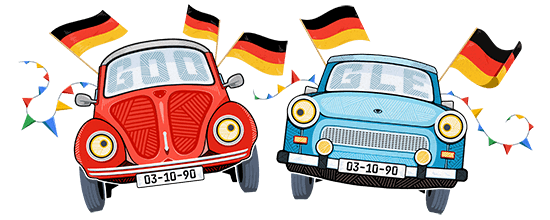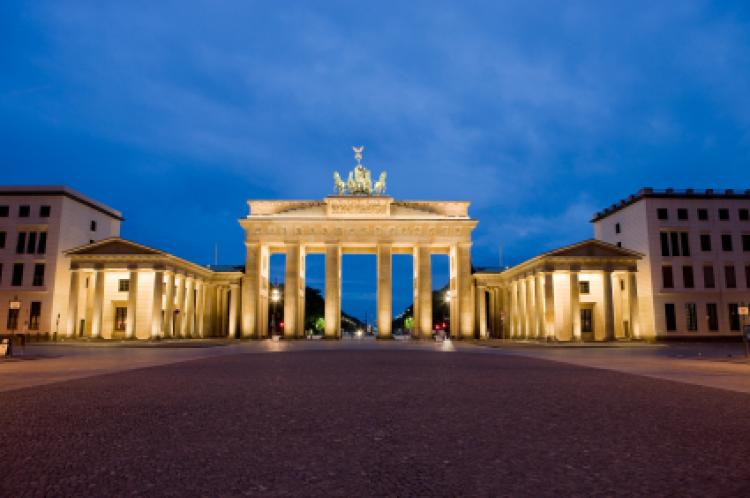
Day of German Unity in Germany
German Unity Day (Tag der Deutschen Einheit)
is annually held on October 3 to mark the anniversary of the nation's
unification. It remembers when the Federal Republic of Germany and the
Democratic Republic of Germany united to create one single, federal
Germany on October 3, 1990.

What Do People Do?
Many people have a day off work and big public celebrations are organized. These include:- Speeches by politicians and other leaders.
- Concerts.
- Communal meals.
- Food and culture presentations from Germany's regions.
- Fireworks.
Public Life
German Unity Day is a public holiday in Germany so post offices, banks and many businesses are closed. Nearly all stores are closed, although a few may be open in some city areas. Bakeries, petrol stations and stores at railway stations, airports and near highways are often open. Public transport services may run as usual, at a reduced service or no service depending on where one lives or intends to travel. There may be some disruption to traffic around large celebrations.Background
Following World War II, the area that was Germany was divided into four military sectors controlled by France, the United Kingdom, the United States and the Soviet Union. On May 23, 1949, the sectors controlled by France, the United Kingdom and the United States became the Federal Republic of Germany. On October 7, 1949, the sector controlled by the Soviet Union became the German Democratic Republic, which in Germany is generally referred to as the DDR (Deutsche Demokratische Republik).The two countries developed very different political and economic systems and, due to the political tensions in post-war Europe, there was little contact between the inhabitants of the two countries. Life in the DDR was characterized by harsh repression against political adversaries. Thousands of inhabitants were kept under intimate surveillance by the infamous East German secret police, the Stasi (Staatssicherheit). At least 137 people died trying to escape from the DDR.
On September 4, 1989 citizens of Leipzig protested peacefully against the DDR government. More so-called “Monday demonstrations” soon took place in other cities across the DDR. The protests called for political reform and to open the borders. On November 9, 1989, the checkpoints between the two countries were opened and people were allowed to travel freely. This date marked the "fall" of the Berlin wall.
These events lead to political change. Democratic elections paved the way for unity in the German Democratic Republic on March 18, 1990. The "Treaty of Unification" was signed by both countries' leaders in August that year. Finally, Germany's unification became official on October 3, 1990.
Symbols
The Brandenburg Gate and the Berlin wall were two important symbols of Germany's division following World War II and Berlin's and Germany's unification in 1990. Images of the Brandenburg Gate and the Berlin wall's destruction are often displayed on German Unity Day. The German unification treaty also symbolizes the day and its meaning.Germany's flag is displayed, particularly on public buildings, on German Unity Day. This flag is three units high and five units wide and is divided horizontally into thirds. The top third is jet black, the middle third traffic red and the bottom third is gold. Together these colors represent the freedom of Germany as a whole and each of its people. In the past, the colors represented: the darkness of servitude (black); bloody conflict (red); and the light of freedom (gold).
Many ESC fans from all over the world are so very sad because we lost Joy Fleming - one of the best singers ever.
Betty MacDonald fan club founder Wolfgang Hampel sings 'Try to remember' especially for Betty MacDonald fan club organizer Linde Lund at Vita Magica September
you can join
Betty MacDonald fan club
Betty MacDonald Society
Vita Magica
Eurovision Song Contest Fan Club
on Facebook
Vita Magica Betty MacDonald event with Wolfgang Hampel, Thomas Bödigheimer and Friedrich von Hoheneichen
Vita Magica
Betty MacDonald
Betty MacDonald fan club
Betty MacDonald fan club on Facebook
Betty MacDonald forum
Wolfgang Hampel - Wikipedia ( English )
Wolfgang Hampel - Wikipedia ( English ) - The Egg and I
Wolfgang Hampel - Wikipedia ( Polski)
Wolfgang Hampel - Wikipedia ( German )
Wolfgang Hampel - LinkFang ( German )
Wolfgang Hampel - Academic ( German )
Wolfgang Hampel - cyclopaedia.net ( German )
Wolfgang Hampel - DBpedia ( English / German )
Wolfgang Hampel - people check ( English )
Wolfgang Hampel - Memim ( English )
Vashon Island - Wikipedia ( German )
Wolfgang Hampel - Monica Sone - Wikipedia ( English )
Wolfgang Hampel - Ma and Pa Kettle - Wikipedia ( English )
Wolfgang Hampel - Ma and Pa Kettle - Wikipedia ( French )
Wolfgang Hampel - Mrs. Piggle-Wiggle - Wikipedia ( English)
Wolfgang Hampel in Florida State University
Betty MacDonald fan club founder Wolfgang Hampel
Betty MacDonald fan club interviews on CD/DVD
Betty MacDonald fan club items
Betty MacDonald fan club items - comments
Betty MacDonald fan club - The Stove and I
Betty MacDonald fan club groups
Betty MacDonald fan club organizer Linde Lund
Betty MacDonald fan club organizer Greta Larson
